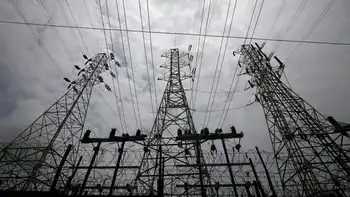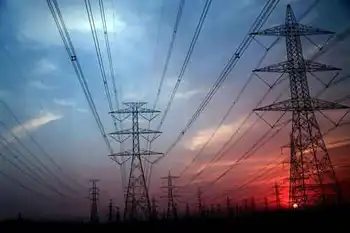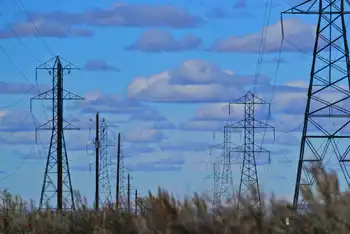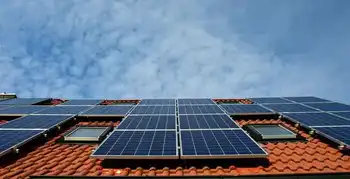Wind plans generate disagreement
By Rochester Business Journal
NFPA 70b Training - Electrical Maintenance
Our customized live online or in‑person group training can be delivered to your staff at your location.

- Live Online
- 12 hours Instructor-led
- Group Training Available
NYPA representatives have been reviewing five proposals over the last 10 months, and are tight-lipped about the process. President and CEO Richard Kessel has declined to comment on the status of the project, which has been condemned by governments in Monroe and most New York counties along the shores of the two lakes.
"It's really sad that the lake counties in New York have said no to NYPA for the exploration," says Kevin Schulte, co-founder and CEO of Sustainable Energy Developments Inc. in Ontario, Wayne County.
"What it says to me is they don't even want to understand what that opportunity could be. NYPA doesn't understand what the economics will be, or what those projects are even going to look like."
Monroe and Wayne counties in the Rochester area have passed resolutions against the placement of wind turbines off their shores. Niagara, Erie and Chautauqua counties in Western New York have done the same, as have Oswego and Jefferson counties on the east end of Lake Ontario.
Orleans and Cayuga counties have yet to publicly state their position.
In a statement, NYPA said it respects legislators' views but is keeping options open as it decides where to locate the turbines.
Schulte's company has developed 30 residential wind turbines in New York that generate at least 10 kilowatts of electricity. It has projects — ranging from 50 kilowatts to 2 megawatts — from Delaware to New Hampshire, all of which directly power facilities, he says.
Sustainable Energy Developments will not be involved in the NYPA project, whose scale will be 120 to 500 megawatts, NYPA officials say.
"Some are five or 10 years away from ever being built," Schulte says. "I just think it's sad that we're not even willing to explore that opportunity to make sure we understand whether or not there's an economic opportunity for the communities along the lake shore.
"I would've thought the communities on the lake shores would be more progressive. It's not as though our economy in these parts is growing at an all-time rate or anything."
Some 48 businesses from the Rochester area are among 368 registered on the power authority website to be part of the project. O'Connell Electric Co. Inc. in Victor is one of them.
"When that thing came out, we did discuss it with some of these developers," O'Connell CEO Victor Salerno says.
"Everybody was all upset about putting them up off of Monroe County. I mean, they're not going to go there. There's supposedly a site on Lake Erie that they may pursue. There again, these are all rumors. You can't get anything straight out of them."
Salerno thinks the turbine project is likely to wind up on Galloo Island, on the eastern end of Lake Ontario near Sackets Harbor, rather than in the water.
"There is a site that makes all the sense in the world," he says. "It's an uninhabited island. But it's an island. Turbine placement is not in the water, but you can probably build it for 50 percent less. It makes too much sense, so I still imagine that will happen."
Galloo Island already is of interest to Upstate New York Power Corp. in suburban Buffalo, which is seeking governmental and regulatory approvals for up to 90 turbines generating 269 megawatts of power, documents filed with the state Department of Environmental Conservation state.
"It's like nine miles into the lake," Salerno says. "It is a perfect spot. The wind screams down the lake with nothing in the way. It's probably one of the best wind usages in the country.
"The jobs are desperately needed there," he adds. "I'm guessing there would be $500 million or $600 million private contracts. You'd think they'd be all over it. This power authority has been a big mystery all along. Everything's been done in secret with them. I think it will happen, but it should've happened already. It's too logical."
The task of siting wind energy projects has become a science, Salerno says.
"They know exactly what to expect, based on historical data," he says. "They don't just plop it anywhere. You're not going to put them in residential areas. They have to be within certain distances and all that stuff.
"Then you have the aesthetics. I mean, they are huge. They're 40-story buildings."
O'Connell has been part of 12 large-scale wind energy projects, Salerno says, developing substations, transmission lines and tower wiring.
Among them are the $40 million conversion of an abandoned Bethlehem Steel Corp. plant in Lackawanna to the Steel Winds Urban Wind Farm and the $200 million Bliss Wind Farm in Wyoming County.
"We're bidding on one right now that I think we're going to get," Salerno says. "It's south of Rochester, not in Monroe County. And I think we're going to put an addition on the one we built at Steel Winds. They're going to put maybe a half dozen more towers there. But there are a lot of them pending in the area. They will happen."
Wind power projects provide a boost to the local economy, Salerno says.
"There's the cost to build them, and there's all kinds of labor that goes into it," he says. "O'Connell's is uniquely positioned because we have a power group. We do the line work, and no one locally does that other than ourselves. We have competition, but it's out of the area.
"We've done over a dozen of the big ones, and we're trying to help some of these smaller companies with the small wind. That'll come. It's happening. As oil keeps going up, that makes the payback quicker."
O'Connell did the electrical work for the 125-megawatt Cohocton Wind farm south of Naples in Steuben County. The 2008 project developed by First Wind, an independent wind energy company based in Boston, included 50 turbines generating 2.5 megawatts each.
"You can actually see it from Canandaigua Lake," Salerno says. "We have a place on the lake and, when it's a clear day, we can see about nine of the towers. They're kind of intriguing, but they're big."
The town of Cohocton receives annual payments of some $750,000 as part of its 20-year host agreement with First Wind and from a payment-in-lieu-of-taxes agreement through the Steuben County Industrial Development Agency, Supervisor Jack Zigenfus says.
Cohocton decided to take larger annual payments early to pay off substantial debt, rather than equal payments over 20 years, the 10-year supervisor says.
"The town had a lot of debt," Zigenfus says. "It was not in good financial shape at all. By taking the larger amount of money up front, we were able to pay off all the town's debt.
"It also allowed us to purchase some very expensive highway equipment. And we have some healthy reserves."
The town tax rate was reduced by 60 percent over two years and is now in the range of $2.85 per thousand, he says.
There have been virtually no complaints about the visual impact or noise coming from the turbines, Zigenfus says.
"Beauty is in the eye of the beholder," he says. "Some people don't like the view. Some people don't like the inconveniences of the noise. There are some issues with noise, but these are few and far between. We receive almost no complaints anymore."
A 16-turbine wind farm is proposed for neighboring Prattsburgh, but town officials are waging a legal battle against the developer, Ecogen LLC, over regulatory issues. A ruling last month by state Supreme Court judge John Ark gives Ecogen and the town five months to reach agreement on plans for road use.
"It's not really a case of being for or against," Prattsburgh supervisor Albert Wordingham says. "Regardless of what industry it is-whether it's wind towers or a dump or tire-shredding-they have to be sited properly.
"That's one of the major problems here: the proximity to people's homes. It's inadequate. It's not how I feel about it, but what the world-Europe, in particular-has learned over the years about setbacks and safety issues and shadow flicker."
Shadow flicker occurs when certain conditions cause rotating turbine blades to cast lengthy shadows.
Wordingham has no issues with wind farms, he says, as long as the setbacks adequately ensure the health and safety of residents.
"There are basically no rules," he says. "It's a free-for-all. The rules are woefully inadequate. For whatever reason, most of the lead agents that do the state environmental quality review process and the findings statements are not paying attention to problems and issues in the world.
"Our basic issue here is the setbacks. You can't displace the people that live here to do a project just because it's convenient. It has to be done properly."
Schulte of Sustainable Energy Development thinks wind energy opponents overshadow those in favor of the alternative resource.
"I don't think New York is unique," he says. "We work all across the Northeast. You have a rather vocal minority that opposes a project and, unfortunately, a quiet majority that's very supportive of wind power."
New York's regulatory environment does make it difficult for large wind projects, Schulte adds.
"That probably has slowed projects down more than the un-silent minority," he says.
SED doubled its business in 2010, Schulte says, and sales for 2011 are at an all-time high.
"We're certainly seeing a pretty steep growth curve at this point," he says.
"For the first time in the nine years that SED has been doing business here, I can look at these types of projects in New York state and see real positive economic benefit for people that own a windy property and want to take advantage of wind power."
Salerno says wind power is part of the long-term solution to the spiraling cost of oil.
"If I owned a nice home on Lake Ontario, in Webster or Charlotte, I wouldn't worry about wind towers going there," he says. "I don't think it's going to happen. But if you site them in the right spots, it is part of the solution."
Adds Salerno: "If you want your lights on, if you want to run your computers, if you want to run your air conditioning, guess what? You need to generate electricity some way. I don't think we want to go back into the dark ages."











